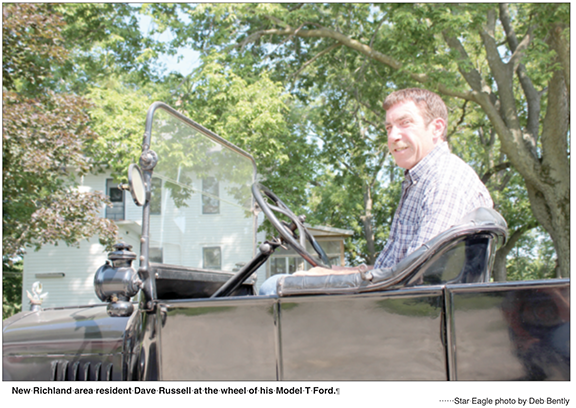 By DEB BENTLY
By DEB BENTLY
Staff Writer
Dave Russel grew up hearing stories his Grandpa Harold, born in 1908, would tell about driving Model T cars. “He had all kinds of stories,” Dave remembers. “He would talk about riding in them, driving them. He made it sound somehow special.”
Harold died in 1983, two years before Dave graduated from New Richland-Hartland High School. “The idea of owning a Model T just stuck with me,” he says. Son of local farmers Curtis and Darlene, Dave joined his parents operating the family farm along Hound Street northwest of New Richland. In 2010, his memories of Harold’s stories was still strong enough that “I had the chance to buy a Model T, and I decided I might as well do it.”
Though he admits some might not see the sense in owning a vehicle which must be cranked to start and has a top comfortable speed of between 30 and 35 mph, he says he has never regretted acquiring the vehicle.
For one thing, he admires its engineering. “The simplicity is a connection to another time,” he observes. The Model T’s four-cylinder engine is small compared to a modern vehicle’s. It has headlights, but no tail lights or signals. His particular model, from 1919, has only one door allowing access to the front seat, from the passenger side.
The accelerator is a sliding lever mounted just below the steering wheel. There are three floor pedals–one is the brake, one is reverse, and the other puts the car in low gear when pressed to the floor but becomes high gear when it’s released.
“It’s a bunch of details you can understand right away,” he comments. “But when you’re driving down the road, you have to remind yourself; you get a feel for it.
“Trouble is, the pedals are small, and I’ve got big feet.”
Starting the car requires a crank. “You turn the key, then you turn the crank and hope,” he jokes. “Sometimes it takes a few cranks before it gets going.”
Asked to compare the physical exertion needed to turn the crank, Dave suggests it requires about as much effort as lifting a heavy snow shovel full of snow. Another similarity: one shovel of snow is not exhausting, but it doesn’t take many consecutive scoops before the work is difficult. The same might be true of turning the crank. Though many might believe the crank can be turned repeatedly, the practice is actually to give it one turn at a time.
Dave says he has never had much training as a mechanic, except that he has lived on a farm his entire life. “Getting old equipment through another season, that teaches you to fix things,” he observes. In the 14 years he’s owned the Model T, he has fixed the fan belt and fan blades, replaced some of the wiring, and repaired some of the wooden spokes in the wheels.
He says it is surprisingly easy to acquire replacement parts. For one thing, the Model T was mass produced from 1908 to 1927. Parts are fairly interchangeable across years. For another, the Ford corporate website reports more than 15 million were made. He also says he enjoys the straightforward nature of the repairs. The simplicity of the machine and the humble engineering make it a pleasant task.
Also pleasant, he says, is an unhurried ride with the top down along a country road.
“You see everything differently that way,” he observes. “You can’t help thinking about the way things used to be.” Another reason to take it easy while driving, Dave observes, is because the vehicle has springs, but no shock absorbers. Bumps, and especially washboards, lead to what Dave jokingly calls “a funny kind of dancing” along the road.
Dave mentions he has been impressed with the longevity of the Model T, which celebrated its hundredth anniversary in 2019–the same year it won “best in show” at the New Richland Farm and City Days car show, its one scheduled outing each year. He figures the car has many more good years in it.
And though he jokes the car “gets about an hour of driving a year” he mentions some pleasant rides with friends and family members.
“It gets a fair amount of attention when it’s out in public,” he admits. He says people ask questions about how the car starts, how fast it can go, and, of course, how old it is. When he meets other cars while driving, he says, “I never fail to get a wave.”
One last way the car’s simplicity comes into play, perhaps, is the many connections the car provides to Dave’s roots and his farm family. For that reason, even though the Model T would probably bring $10,000 or so if it were offered for sale, Dave indicates he is “simply” not planning to sell anytime soon.
